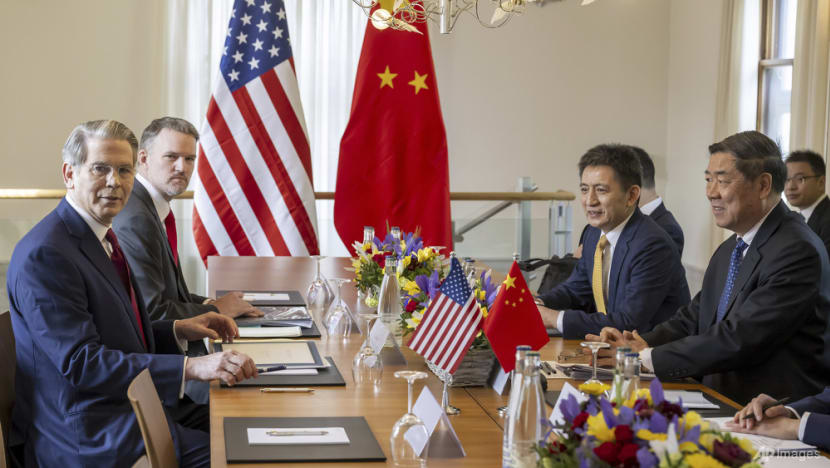Commentary: Trump blinked again on tariffs, but China isn’t in the clear
There’s an irony to claiming victory in a trade war that yields no winners, says former SCMP editor-in-chief Wang Xiangwei.

US Secretary of the Treasury Scott Bessent, left, US Trade Representative Jamieson Greer, second left, Chinese ambassador to the World Trade Organization Li Chenggang, second right, and Chinese Vice Premier He Lifeng, right, attend a bilateral meeting in Geneva, Switzerland, on May 10, 2025. (Martial Trezzini/Keystone via AP)

This audio is generated by an AI tool.
HONG KONG: A trade war yields no winners. This notion has become widely accepted, since United States President Donald Trump sparked an escalating trade conflict with China last month, effectively bringing trade between the two largest economies to a near standstill.
The irony was palpable this week when both the US and China claimed victories after announcing a temporary tariff truce on Monday (May 12). This agreement drastically reduces tariffs on each other's goods for 90 days to ease tensions.
Mr Trump, in his characteristically grandiose manner, declared a victory, touting "a total reset" with China and hinting, without specifics, that China had agreed to fully open its markets to American businesses. The White House release hailed it a “historic trade win”.
Chinese state media and social media influencers hailed the agreement as "a great victory" for China.
However, beneath the spin and hyperbole lies the reality that this so-called "reset" will be far from straightforward.
LIMITED VICTORIES
Finalising a comprehensive deal could take months of challenging negotiations, considering trade and tariff discussions are likely part of broader negotiations involving issues such as fentanyl, semiconductors, rare earth elements, TikTok, Panama Canal ports, and possibly Taiwan.
And this assumes there are no further reversals due to Mr Trump's unpredictable nature or if talks go badly.
Signs suggest that Mr Trump's victory claim is hollow and disingenuous. After swiftly raising tariffs to 145 per cent, he expected Beijing to capitulate first.
But he grossly underestimated Beijing's political strategy, as well as its readiness and resolve to endure short-term economic hardship. In a strategic twist, Beijing effectively adopted Mr Trump's own tactic of maximum pressure, coupled with strong rhetoric about "fighting to the end”.
This hard-nosed approach has paid off, ultimately forcing Mr Trump to yield. And make no mistake, Mr Trump blinked first – even if the US appears to impose a larger tariff on Chinese imports than the other way around for now.
Yet, China's "great victory" carries more political and geopolitical implications than economic benefits.
From a Chinese perspective, being the first and only country to stand up to Mr Trump's bullying tactics and win positions China as an undisputed equal to the US in the great power game – a status Chinese President Xi Jinping once described as "viewing the world as equals". This victory could bolster China's standing and improve its credentials as a leader of the Global South.
Economically, however, China faces mounting costs from the trade war, especially as its economy struggles with deflation and weak consumer confidence. That explains why Beijing is willing to sit down to talk with Washington. After all, a prolonged trade war could complicate or even derail China’s efforts to boost its economy.
More importantly, Beijing still follows the strategy formulated after Mr Trump’s first trade war against China in 2018: fighting but not breaking off.
TARIFFS REMAIN SUBSTANTIAL
Even after rollback, American tariffs on Chinese products remain substantial, particularly given that exporters' margins are typically between 10 per cent and 20 per cent.
The revised “Liberation Day” tariffs now stand at 30 per cent, down from 145 per cent. This comprises the 10 per cent baseline on all trading partners and 20 per cent fentanyl-related levy. Sector-specific tariffs like those on steel and cars remain.
If this rate persists, it could lead to a 36 per cent decline in China's exports to the US and a 5 per cent decrease in China's total exports, shaving 1 percentage point off this year's GDP growth, according to Larry Hu, chief China economist at Macquarie Group in a research note this week.
But don’t forget there were pre-existing tariffs before Mr Trump started his second term. Taken together, the overall US tariff rate on Chinese goods is closer to 50 per cent.
Similarly, China's reciprocal tariff has fallen to 10 per cent from 125 per cent. However, after factoring in the pre-existing tariffs, China's overall tariff rate on US products stands around 30 per cent.
WHAT HAPPENS NEXT?
For trade talks to advance, Mr Trump and Mr Xi will need to be actively involved in defining the parameters of a final deal. Mr Trump has suggested he may soon speak with Mr Xi by phone, which could lend credence to the best-case scenario of both sides working towards a comprehensive trade agreement.
Questions arise about how China is prepared to open up to American businesses, as Mr Trump claimed, and how the US is prepared to reciprocate.
From China's perspective, there are several steps it can take to reduce trade imbalances, a major source of tension between the two countries.
First, Beijing is ready to significantly increase purchases of American agricultural products and energy to reduce the trade deficit. Second, it can take measures to limit exports to the US, a trend already emerging as exporters diversify into other markets. Third, Beijing can continue to increase its holdings of US Treasury securities – China is the second-largest holder, with US$784 billion, after Japan. Fourth, Beijing can encourage more Chinese companies to invest in the US.
However, many questions remain. What concessions can the US offer China in return?
Can the US relax controls over high-tech products, including semiconductors? Even if Chinese companies wish to invest in the US, will they be welcomed at a time when even Chinese-produced garlic is deemed a national security threat?
Finding answers to these questions will not be easy.
Wang Xiangwei is a former Editor-In-Chief of South China Morning Post. He now teaches journalism at Hong Kong Baptist University.



















